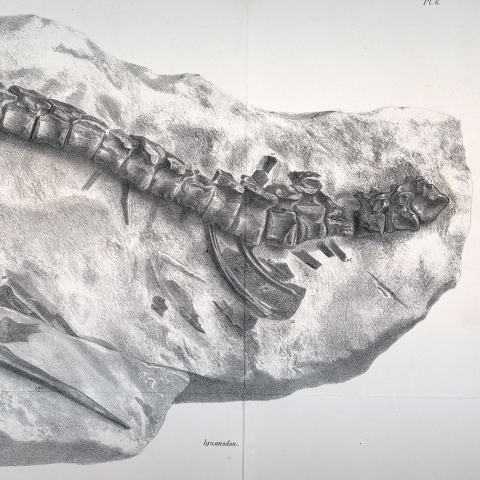

A team of international scientists have traced the origins of deep-sea ecosystems, revealing how marine life evolved in the depths of the ocean over hundreds of millions of years
12 February 2025
8
A team of international scientists, including from the University of Portsmouth, have traced the origins of deep-sea ecosystems, revealing how marine life evolved in the depths of the ocean over hundreds of millions of years.
Dr Nic Minter, Associate Professor in Analytical and Experimental Palaeontology at Portsmouth, was part of the team that analysed trace fossils - evidence left behind by ancient creatures in sedimentary rock. These fossils, found in over 100 locations worldwide, help explain how life first took hold in deep-sea environments.
The study, published in the Proceedings of the National Academy of Sciences (PNAS), shows that the development of modern deep-sea ecosystems was a slow process, taking around 100 million years.
The research team - led by Dr Luis Buatois from the University of Saskatchewan (USask) - discovered that as tiny organisms burrowed into the seafloor, they helped increase oxygen levels, creating an environment where more complex life could thrive. The activities of animals, where they modify and impact their own environment, is referred to as ecosystem engineering.
This period of change coincided with a cooling trend during the Ordovician Period, which began about 485 million years ago. The deep-sea is the most extensive region on Earth, covering 90 per cent of the ocean floor.
Modern deep-sea ecosystems have been barely explored and their evolutionary origin is poorly understood. Since most body fossils occur in rocks formed in shallow water, reconstructing the evolution of deep-sea communities has been challenging.
Dr Minter, from the University of Portsmouth’s School of the Environment and Life Sciences, said: “Despite making up the majority of our Earth’s surface, we know less about deep-sea environments and their evolution than we know about the surface of Mars
“Most of what we know about early marine life comes from fossils found in shallow waters. But deep-sea environments are much harder to study because body fossils are so rare.
“Luckily, deep-sea deposits contain an abundance of trace fossils. Trace fossils are probably a less well-known type of fossil because, rather than the bodily remains of a long-dead animal, they record the life activities of ancient creatures in the form of burrows, trails, and trackways.
“The trace fossil record gives us snapshots of ancient communities by telling us what extinct animals were doing, where and when they were doing it, and with whom else they were living and interacting. By examining trace fossils - patterns left behind by ancient creatures - we can open a window into a largely unexplored part of Earth’s history.”
The study provides valuable insights into how environmental changes, such as shifts in ocean oxygen levels, affected marine ecosystems over time. As ocean currents pushed water down across deep-sea sediment, they provided oxygen used by bacteria growing within trace fossil burrows.
The establishment of these bacterial farms shows there were communities of organisms that had evolved strategies to feed in an otherwise food-scarce environment, eventually leading to more and more of these organisms appearing in oceans around the world.
“From our database, we know when those burrows became much more common”, explained Dr Buatois.
“What we have seen here is how this deep marine ecosystem was constructed through time. We are trying to look at the timing of innovation; track the origin for modern deep-sea communities. It’s like opening a window into the history of an environment that has only been marginally explored. We are just scratching the surface.”
The fossil database created during this study will serve as an important resource for future researchers investigating the evolution of deep-sea life. The database was assembled from deep-sea deposits that were between 635 and 359 million years old, and included those that contained trace fossils and those that did not - which allowed the researchers to be confident in the results they were finding.
“This research helps us understand the origins of modern deep-sea ecosystems, which are still some of the least explored parts of our planet,” added Dr Minter. “By piecing together these ancient clues, we gain a better understanding of how marine life evolved and how it might respond to future environmental changes.”
Alongside Buatois, co-authors include Dr. M. Gabriela Mángano (PhD), USask professor in the Department of Geological Sciences and adjunct professor in biology; Dr. Maximiliano Paz (PhD), professor at Oberlin College who earned his PhD at USask; Dr. Nic Minter (PhD), associate professor at the University of Portsmouth who was a postdoctoral fellow at USask; and current USask PhD student Kai Zhou.
More like this...
Fossilised stomach contents shed light on the diet of Early Jurassic pterosaurs
The first-ever discovery of fossilised stomach contents in two 182-million-year-old flying reptile fossils provides palaeontologists with important clues about pterosaur diet and ecology.
23 October 2024
6 min read

Research reveals the most complete dinosaur discovered in the UK in a Century
The most complete dinosaur discovered in this country in the last 100 years, with a pubic hip bone the size of a ‘dinner plate’, has been described in a new paper published today.
10 July 2024
6 min read

New fossil shows Europe had different herbivorous dinosaurs to Asia and America
15 September 2023
5 minutes

